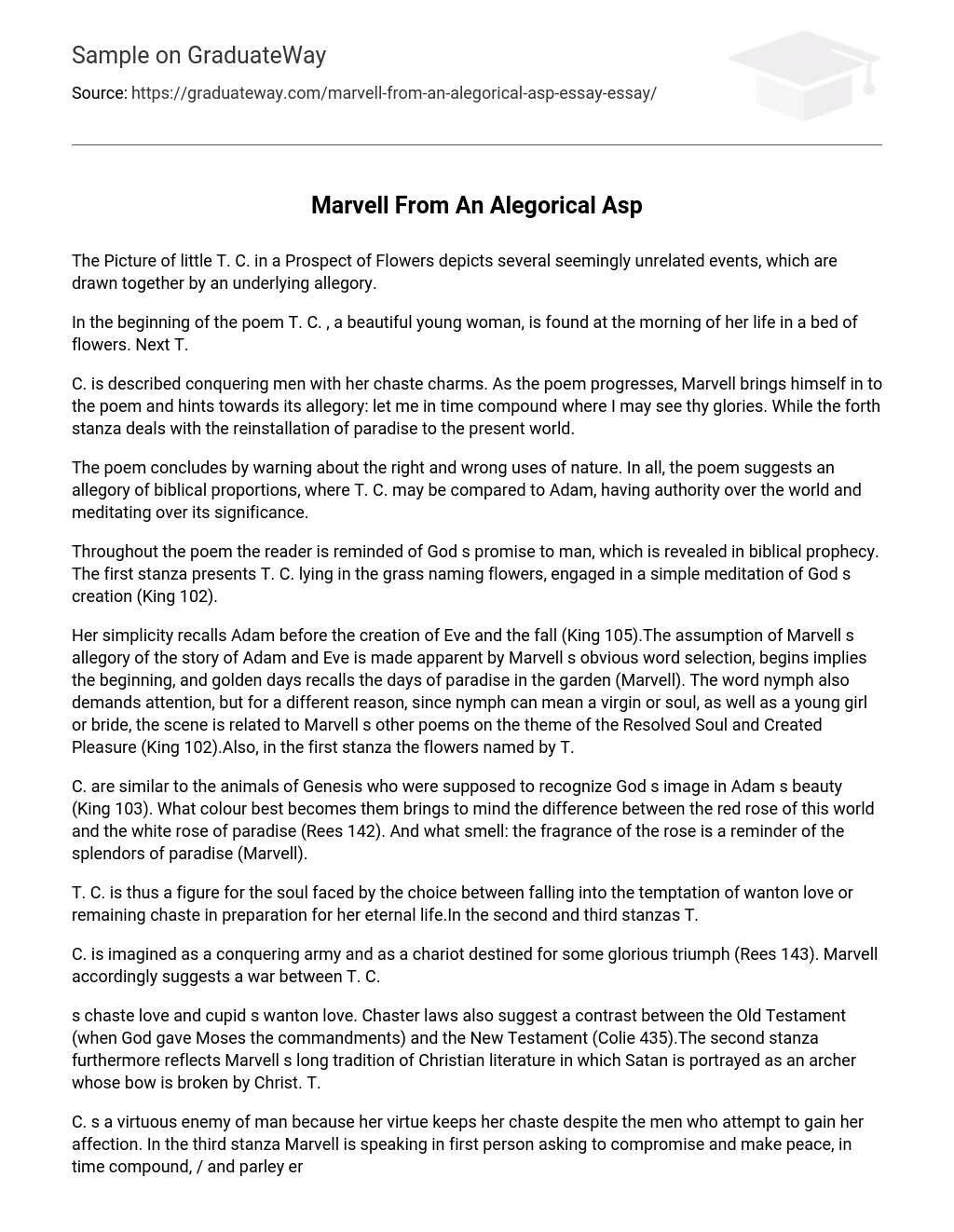The Picture of little T. C. in a Prospect of Flowers depicts several seemingly unrelated events, which are drawn together by an underlying allegory.
In the beginning of the poem T. C. , a beautiful young woman, is found at the morning of her life in a bed of flowers. Next T.
C. is described conquering men with her chaste charms. As the poem progresses, Marvell brings himself in to the poem and hints towards its allegory: let me in time compound where I may see thy glories. While the forth stanza deals with the reinstallation of paradise to the present world.
The poem concludes by warning about the right and wrong uses of nature. In all, the poem suggests an allegory of biblical proportions, where T. C. may be compared to Adam, having authority over the world and meditating over its significance.
Throughout the poem the reader is reminded of God s promise to man, which is revealed in biblical prophecy. The first stanza presents T. C. lying in the grass naming flowers, engaged in a simple meditation of God s creation (King 102).
Her simplicity recalls Adam before the creation of Eve and the fall (King 105).The assumption of Marvell s allegory of the story of Adam and Eve is made apparent by Marvell s obvious word selection, begins implies the beginning, and golden days recalls the days of paradise in the garden (Marvell). The word nymph also demands attention, but for a different reason, since nymph can mean a virgin or soul, as well as a young girl or bride, the scene is related to Marvell s other poems on the theme of the Resolved Soul and Created Pleasure (King 102).Also, in the first stanza the flowers named by T.
C. are similar to the animals of Genesis who were supposed to recognize God s image in Adam s beauty (King 103). What colour best becomes them brings to mind the difference between the red rose of this world and the white rose of paradise (Rees 142). And what smell: the fragrance of the rose is a reminder of the splendors of paradise (Marvell).
T. C. is thus a figure for the soul faced by the choice between falling into the temptation of wanton love or remaining chaste in preparation for her eternal life.In the second and third stanzas T.
C. is imagined as a conquering army and as a chariot destined for some glorious triumph (Rees 143). Marvell accordingly suggests a war between T. C.
s chaste love and cupid s wanton love. Chaster laws also suggest a contrast between the Old Testament (when God gave Moses the commandments) and the New Testament (Colie 435).The second stanza furthermore reflects Marvell s long tradition of Christian literature in which Satan is portrayed as an archer whose bow is broken by Christ. T.
C. s a virtuous enemy of man because her virtue keeps her chaste despite the men who attempt to gain her affection. In the third stanza Marvell is speaking in first person asking to compromise and make peace, in time compound, / and parley ere, before she conquers (Marvell). Her glancing wheels driving in triumph reminds the reader of Christ s victory chariot, on which Christ rides after he defeats Satan (King 105).
Marvell then writes, I may see the glories from some shade, which makes sense because in the bible, men seek shade from the blinding light of God because they are sinners.An example of this is when God talks to Moses and renews the tables, he covers him while His glory passeth by (Exodus 33:22). The shadow in which the speaker seeks refuge is probably Christ who saves man from God s wrath (Rees 144). To see glories from the shade would be to be among those resurrected at the last age: They that dwell under his shadow shall return they shall revive (Rees 144).
Just as Adam disrupted the harmony of the world, so is each person responsible in setting things right by the course of his life (King 106).The forth stanza deals with T. C. correcting the fall of man in the form of nature.
T. C. , in reforming the errours of the spring, gives the flowers qualities, which they lack since the fall (King 106). In the poem, the rose stands for worldliness as opposed to the disarmed rose, which stands for paradise.
The disarming of the rose would be to restore it to its parasidial state (King 107).The reformation is marked by the current state of the flowers as compared to the virtuous state of the flowers during the days of paradise. T. C.
s asked to disarm the roses of the thorns, symbolizing the proposed mission of all men, to try to restore peace during their lives. In the fifth stanza the imagery once again reminds us of mankind s dominion over the creatures (King 107).The reader notices a sharp contrast between the carpe diem message given in To his coy Mistress, a poem written by Marvell, and the passive connotation noticed in the fifth stanza of the The picture of little T. C.
( ). Whereas carpe diem says, seize the day because time is passing, T. C. is told not to anticipate pleasures ( Buds ), but let them ripen in the fullness of time (King 108).
In the title Marvell uses prospect to inform the reader that the poem will look forward in time. The poem progresses through T. C s life as she matures and sets examples for men to live by. T.
C. does not have a monopoly of power in the poem, she is first on earth but lower than God. T. C.
is given great responsibilities and she has high expectations to live up to. The picture of little T. C. takes the reader throughout the progression of human civilization and depicts T.
C. as a Christ-like figure who fixes the wrong that humans have spread on the earth.





